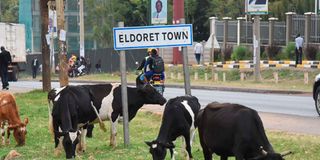Kenya grapples with the reality of methane emissions from cows

Cows grace on the roadside in Eldoret town on December 13, 2023. Cows and other ruminant animals like goats and sheep emit methane gas,which traps 80 times more heat than carbon dioxide, making it a major contributor to climate change.
What you need to know:
- There are different sources of methane emissions globally, including wetlands, agriculture, energy, waste, other natural sources and biomass burning -in that order.
- However, as is the case in most African countries, agriculture, especially livestock production, is the leading cause of methane emissions.
If greenhouse gases were to be ranked according to their potential to have a greater global warming impact, methane would take the lead.
Science shows it is 80 times more potent at retaining warming in the atmosphere, and its impact can linger on for more than 20 years after its release.
The International Energy Agency (IEA) explains that methane has a shorter lifetime in the atmosphere, about 12 years. Still, it captures more energy as long as it lasts, having a more significant warming impact.
It is like an itch that lasts only for a short time but leaves deep scratches that require a lifetime to get rid of the mark left by the scratch.
This is why, on the sidelines of the 28th Conference of Parties (COP28), some countries, including Kenya, signed the Global Methane Pledge. The pledge aims to ensure countries work on plans to reduce methane emissions by at least 30 per cent globally.
This pledge was launched in 2021 at COP26 led by the European Union and the United States. As of March this year, 156 countries had signed the pledge, the latest country being Azerbaijan, where this year's climate conference will take place.
While there is a global target for reducing methane emissions by 2030, the pledge does not give individual countries a target, but it encourages a shared goal.
A preliminary analysis by the International Energy Agency for the Global Methane Tracker shows that the concentration of methane in the atmosphere is now over two-and-a-half times greater than pre-industrial levels.
The increase has accelerated recently and preliminary data indicates another significant annual growth in 2023.
There are different sources of methane emissions globally, including wetlands, agriculture, energy, waste, other natural sources and biomass burning -in that order.
However, as is the case in most African countries, agriculture, especially livestock production, is the leading cause of methane emissions. Rice farming is also a source of methane emissions, and a recent study shows that rice paddies in Africa have led to a 31 per cent increase in emissions.
According to the International Livestock Research Institute 2021 data, the livestock sector contributes about 12 per cent to the country's Gross Domestic Product (GDP).
Livestock keeping is culturally ingrained in some communities, and experts debate how best to reduce emissions from livestock production.
Dr John Recha, a scientist at ILRI, says methane is the most lethal greenhouse gas in terms of its contribution towards climate change.
He explains that methane gas from livestock comes from the burp that ruminants (animals that chew part of what they had already ingested in their stomach, commonly known as cud) release.
He says that there are better ways to keep animals sustainably.
"Pastoralism is a cultural aspect. While it is deep-rooted, we normally aim to reduce the herd size so that we have fewer animals that are fed adequately so they produce more yields," he explains.
"That way, the productivity becomes better because they are not competing for limited water and grass, especially during the dry spells," he adds.
However, he explains that food insecurity is one of the challenges for implementing this. He says it is impossible to ask a hungry family to prioritise reducing their herd size when it is their source of food and livelihood.
Ruth Nyamasage, a climate policy expert who works with NDC partnerships, says methane reduction in Kenya goes beyond reducing livestock sizes and that even as Kenya is a signatory to the global methane pledge, involving local communities is a better way of handling emission reduction.
"It boils down to our action plans. In all our commitments, as much as we do them at the national level, local action has greater impact," she says.
She says Kenya does not yet have a national target for methane reduction. Still, policymakers have proposed mitigation actions on livestock and organic waste management that will contribute to the global methane pledge.
She explains: "Management of livestock does not necessarily mean reducing the numbers; it means ensuring that we have high breeds and enhancing their feeds."
"What they (scientists) do is add mineral components into the feeds so that instead of the cows releasing more methane, they do it with moderation; it's a chemical reaction that happens in the stomach," she adds.
She says that reducing livestock is a political discussion because livestock are our sources of livelihood and part of our culture.
"Generally, as a country, we are taking a conservative approach, especially when anything touches on agriculture and food security. It's not more of a Kenyan approach but that of the Africa Group of Negotiators because our priority is more food security and ensuring the resilience of our economies," says Ruth.





